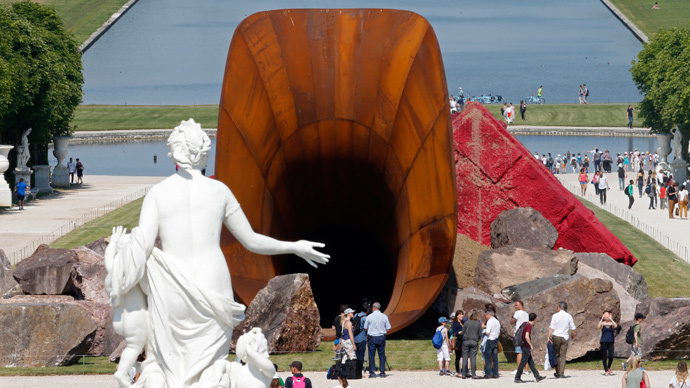French 'intolerance'? Artist outraged after 'queen's vagina' Versailles sculpture is vandalized

A controversial sculpture at the Palace of Versailles that has become known as the "queen's vagina" was sprayed with paint on Wednesday. Anish Kapoor, the artist behind it, attributed "the act of vandalism" to French "intolerance."
"You have to put this in some perspective. If this act of vandalism says something, it speaks more to a certain intolerance in France than to art itself," the British-Indian artist said in an interview with Le Figaro on Thursday.
"The problem seems to me more political than anything
else," the sculptor said.
When your inspiration has dried up: find a masterpiece, and parasitize it : it works ! #AnishKapoor#KPVersaillespic.twitter.com/6uBzKtrsLN
— NoMaternityTraffic (@hdebonnevolonte) June 9, 2015
Saying that he loves France, its "heritage and language," the artist said he yet kept noticing "some discomfort in this country." He added: "This unease has come to punish an object, a pure object, which has no word to defend itself.”
The 60-meter (200-foot) long, 10-meter (33-foot) high
steel-and-rock abstract sculpture was installed in the gardens of
the Palace of Versailles near Paris earlier this month. Facing
the royal chateau, Kapoor's installation – officially named
"Dirty Corner" – was found sprayed with yellow paint
Wednesday.
The latest contemporary artist to be invited to exhibit in @CVersailles throughout the summer is #AnishKapoor! pic.twitter.com/3vqkDNWzOc
— One Art Nation (@OneArtNationTO) June 8, 2015
"Damage to the work, Dirty Corner, was discovered Wednesday morning," the estate's management said, The Guardian reported. "It was lightly sprayed with paint," officials said, adding that the object was being cleaned by palace authorities.
Kapoor said the damage was “significant." Adding that "the vandals came... with large amounts of paint," Kapoor expressed hope that they would be identified, as "there are cameras everywhere in Versailles." No one has yet claimed responsibility for the act, however.
"What a tragedy! How sad!" Kapoor told Le Figaro, adding that he hasn't decided yet on whether he now has "to disassemble it, or leave it as it is." The sculpture was planned to be on display until November.
[IG] TOP: #AnishKapoor, Versailles pic.twitter.com/ZE1Fg4rbge
— drea (@jiyongdar) June 14, 2015
The attack on the “queen’s vagina” was dubbed an attack on freedom of expression by local officials. It is "unacceptable that art, the compass of freedom, suffers because of the obscurantism of some people," officials from the ruling Socialist party said in a statement, The Guardian reported.
French Culture Minister Fleur Pellerin has also expressed "all [my] support to the artist," saying that the offense was "an attack on the freedom to create," AFP cited the minister as saying.
Much ado about nothing. #AnishKapoor's work at #Versailles. Real powerful modern sculpture. pic.twitter.com/BJ0Kb9KHi8
— Natasha Edwards (@parisexpert) June 13, 2015
The exhibition of Kapoor's work at Versailles has become one of the most controversial since the palace opened its grounds to contemporary artists in 2008. Revealed earlier in June, the installation has caused protests against the sculpture regarded to be offensive to both Versailles cultural admirers, as well as defenders of women's dignity. A number of organizations have launched petitions for the works to be removed, Deutsche Welle reported.
Merci à #AnishKapoor et à son #VaginDeLaReine de préparer #Versailles aux saccages de #Daech ! pic.twitter.com/gF9g9J2ims
— Guillaume Navarro (@GuillaumeSeboro) June 9, 2015
Apart from the "Dirty Corner," more of the artist's work is on display, including a cannon that fires red wax at white walls inside the palace. The installation is believed to symbolize a phallus and an ejaculation of blood. The vandalized sculpture outside is said to have been described by Kapoor as "the vagina of a queen who is taking power." The sculptor later said he had been misquoted over the phrase "queen's vagina."
#AnishKapoor@catherinepegard@CVersailles#alfredpacquementpic.twitter.com/X9EY6GL41i
— tgp (@flsoulie) June 5, 2015
"I never used the words from which the controversy was born," Kapoor told Le Figaro. "I never said 'the queen,' I referred to 'her' or 'she' to describe a form that could be feminine, lying on the grass, like an Egyptian queen or a sphinx," he said after the work was vandalized, adding that by calling it the "queen's vagina," people "belittled" it.
READ MORE: XXXmas redacted: Artist removes giant ‘sex toy’ Christmas tree in Paris
"I do not seek provocation," Kapoor said, adding that he did not want to be associated with a protest against controversial contemporary art in France.
Last year, a giant green Christmas tree designed by a US artist Paul McCarthy was erected in the Place Vendome in the center of Paris. Some city residents said the 24-meter-tall artwork resembled a sex toy. After citizens attempted to deflate the installation, its creator decided to remove it.
That object – unlike the Versailles sculpture – was "sexually explicit and claimed as such," Kapoor said.













